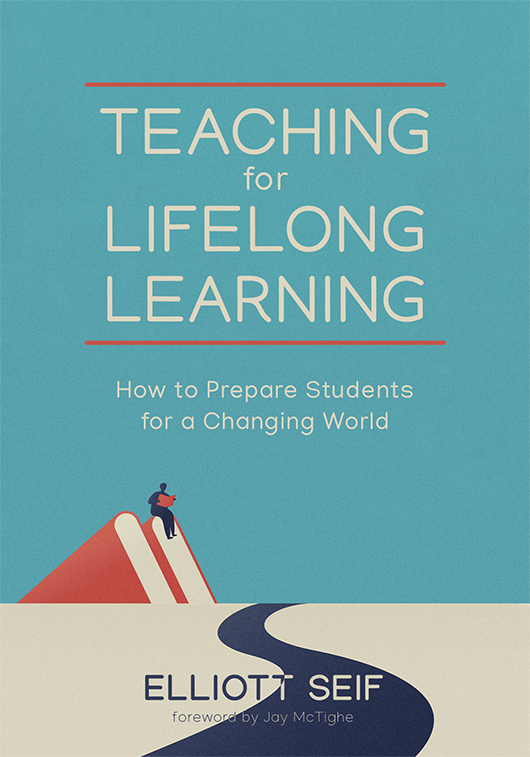Free Reproducibles
Teaching for Lifelong Learning
How to Prepare Students for a Changing World
Develop students into curious explorers and independent thinkers. With this resource, you will explore a lifelong learning approach to education as well as key goals for educational success. Explore many practical ways to improve instruction and assessment that will empower students to not only thrive in the classroom today but also deftly navigate an uncertain and changing world.
Benefits
- Understand the importance of developing curious explorers, independent thinkers, and a growth mindset in students.
- Learn steps, approaches, and specific activities for implementing a four-phase instructional framework.
- Learn why diagnostic, formative, and summative assessments are all important elements of a lifelong learning education.
- Know what to look for when analyzing, choosing, or designing a new curriculum for lifelong learning.
- Explore many lifelong learning education examples from various disciplines and grade levels across elementary, middle school, and high school classrooms.
TABLE OF CONTENTS
Chapter 1: Understanding Educator Goals That Support Students’ Lifelong Learning
Chapter 2: Adapting Instruction for Lifelong Learning
Chapter 3: Assessing for Lifelong Learning
Chapter 4: Developing a Lifelong Learning Curriculum
Chapter 5: Including Project-Based Learning and Civics Education
Chapter 6: Taking the Next Steps
STUDY GUIDE
PRINTABLE REPRODUCIBLES
Introduction
- Reflections—Introduction
- Action Steps—Introduction
- Learning Principles and Suggestions for Teaching and Learning
Chapter 1
Chapter 2
- Reflections—Chapter 2
- Action Steps—Chapter 2
- Lifelong Learning Instruction Recommendations
- Instructional Plan for a Unit of Study
Chapter 3
Chapter 4
- Figure 4.1: UbD Unit Template with Lifelong Learning Descriptors
- Reflection Questions—Chapter 4
- Action Steps—Chapter 4
- Curriculum Rating System
- Citizenship Unit for Elementary School Students
- Science Unit for Middle School Students
- Poetry Unit for High School Students
Chapter 5
Chapter 6
- Reflections—Chapter 6
- Action Steps—Chapter 6
- Designing a Lifelong Learning Education Professional Development Plan
- Planning Tool for Creating a Mission and Vision Statement
- Lifelong Learning Education Analysis
SUGGESTED RESOURCES
Books
- Dimich, N. (2014). Design in five: Essential phases to create engaging assessment practice. Bloomington, IN: Solution Tree Press.
- DuFour, R., DuFour, R., Eaker, R., Many, T. W., & Mattos, M. (2016). Learning by doing: A handbook for Professional Learning Communities at Work. Bloomington, IN: Solution Tree Press.
- Fogarty, R. J., Kerns, G. M., & Pete, B. M. (2020). Literacy reframed: How a focus on decoding, vocabulary, and background knowledge improves reading comprehension. Bloomington, IN: Solution Tree Press.
- Marzano, R. J. (2019). The handbook for the new art and science of teaching. Bloomington, IN: Solution Tree Press.
- McTighe, J., & Seif, E. (2010). An implementation framework to support 21st century skills. In J. Bellanca & R. Brandt (Eds.), 21st century skills: Rethinking how students learn (pp. 149–172). Bloomington, IN: Solution Tree Press.
- Stobaugh, R. (2019). Fifty strategies to boost cognitive engagement: Creating a thinking culture in the classroom. Bloomington, IN: Solution Tree Press.
Websites
- “6 Best Mind Mapping Tools for Creative Students” (Meiser, 2016)
- Activate Learning
- Annenberg Classroom: The Annenberg Guide to the United States Constitution
- Bob Pearlman
- Center for Civic Education
- Coalition of Essential Schools
- Curriculum21
- Digital Civics Toolkit
- Education Week: Projects, Portfolios, and Performance Assessments
- Expeditionary Learning Education
- Facing History and Ourselves: Socratic Seminar
- “Fourteen Activators That Will Give Your Lessons Pop” (Comprehension Connection, n.d.)
- Graphic Organizer Maker
- High Tech High
- iCivics
- “Interactive Notebooks: Meeting the Needs of English Language Learners” (Olivares, 2012)
- Jay McTighe and Associates Consulting
- Jim Collins
- Learning Policy Institute: California Performance Assessment Collaborative
- Massachusetts Department of Elementary and Secondary Education: Model Curriculum Units
- MC2 STEM High School Capstone Design Process
- New York Performance Standards Consortium
- PBLWorks
- Performance Assessment Resource Bank
- Project Zero
- RubiStar
- The Project Approach
- Vermont Writing Collaborative: Writing for Understanding
- “What Is a Curriculum Map . . . and How Do You Make One?” (Zook, 2018)

